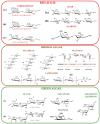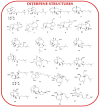Bioactive Compounds of Marine Algae and Their Potential Health and Nutraceutical Applications: A Review
- PMID: 40278274
- PMCID: PMC12029074
- DOI: 10.3390/md23040152
Bioactive Compounds of Marine Algae and Their Potential Health and Nutraceutical Applications: A Review
Abstract
Currently, marine algae are still an under-exploited natural bioresource of bioactive compounds. Seaweeds represent a sustainable source for obtaining bioactive compounds that can be useful for the fabrication of new active products with biomedical benefits and applications as biomedicinals and nutraceuticals. The objective of this review is to highlight scientific papers that identify biocompounds from marine macroalgae and emphasize their benefits. The method used was data analysis to systematize information to identify biocompounds and their various benefits in pharmaceuticals, cosmetics, and nutraceuticals. The research results demonstrate the multiple uses of seaweeds. As pharmaceuticals, seaweeds are rich sources of bioactive compounds like polysaccharides, protein compounds, pigments, and polyphenols, which have demonstrated various pharmacological activities such as antioxidant, antibacterial, anti-inflammatory, antiviral, anticoagulant, and potentially anticarcinogenic effects. Seaweed has gained recognition as a functional food and offers a unique set of compounds that promote body health, including vitamins, minerals, and antioxidants. In conclusion, the importance of this review is to expand the possibilities for utilizing natural resources by broadening the areas of research for human health and marine nutraceuticals.
Keywords: anti-cancer potential; anti-inflammatory effects; antioxidant properties; dietary supplements; functional foods; nutraceuticals; nutritional composition; seaweeds.
Conflict of interest statement
The authors declare no conflicts of interest.
Figures










References
-
- Cadar E., Axinte E.R., Amzoiu M., Jurja S., Cherim M. Preliminary study on the marine algae from the romanian Black Sea coast. J. Sci. Arts. 2019;4:989–1000.
-
- Ferrara L. Seaweeds: A Food for Our Future. J. Food Chem. Nanotechnol. 2020;6:56–64. doi: 10.17756/jfcn.2020-084. - DOI
Publication types
MeSH terms
Substances
LinkOut - more resources
Full Text Sources
Medical
Research Materials

